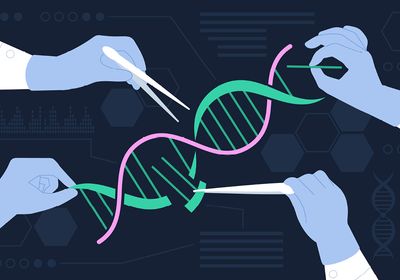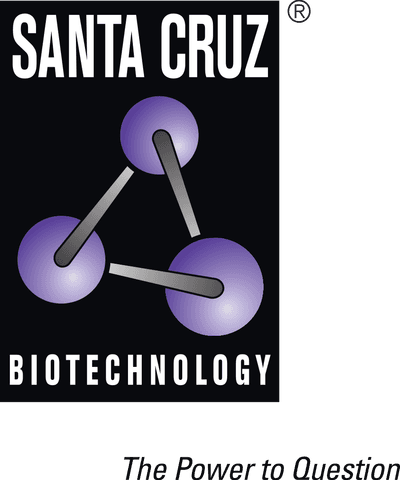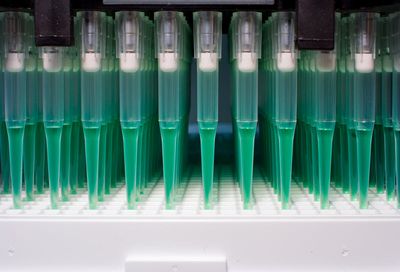ABOVE: Tumors interact with surrounding neurons to promote their survival and growth. Erin Lemieux
Brain tumors that occur in glial cells, gliomas, can be highly proliferative. With limited therapeutic options available, researchers have turned to studying the growth patterns of these difficult-to-treat cancers to identify new treatment avenues.
For more than a decade, Michelle Monje, a neurooncologist at Stanford University, has studied these cancers. Her team and other groups found that induced neural activity promotes tumor survival and growth.1-4 Upon investigating this further in a new study, Monje’s group showed that gliomas also use neural plasticity, a process neurons use to promote learning and memory by strengthening connections through increased signaling between cells, for survival.5 Their findings, published in Nature, could offer a new mechanism for drug targeting. “It’s not that the cancer is inventing anything new,” Monje said. “It’s really kind of hijacking and subverting normal mechanisms of development and plasticity for its own growth and progression.”
See also “Machine Learning for Predicting Glioblastoma Prognosis”
Based on their previous findings that the signaling factor brain-derived neurotrophic factor (BDNF) promotes tumor growth, the team transplanted gliomas from pediatric patients into either normal mice or those that could not produce BDNF after optogenetic activation. The team showed reduced tumor growth in mice that did not secrete BDNF compared to those that did, hinting that the gliomas sequestered BDNF produced by healthy neurons to proliferate. “It had a bigger effect than we expected,” Monje said. “It's a weak mitogen; it causes a little bit of proliferation. We expected that blocking it might have helped a little bit, but it helped a lot.”
“It is an incredibly challenging and exciting technology that she's using to understand how these glioma cells kind of sustain their growth and become so aggressive,” said Atique Ahmed, a cancer biologist studying glioblastomas and cancer cell plasticity at Northwestern University who was not involved in the study.
See also “Capturing the Brain Tumor Microenvironment with Tissue Engineering”
In healthy brains, BDNF signaling through its receptor, Tropomyosin receptor kinase B (TrkB), regulates glutamate-driven synapses, so Monje’s group investigated the effect of BDNF on the neuron-tumor connection.6,7 The researchers used short hairpin RNAs to reduce gene expression of NTRK2, which codes for TrkB, and they transplanted these edited and unedited tumor cells into mouse brains and let them establish in the tissue. Then the team used patch clamp electrophysiology on BNDF-treated brain slices from these mice. They observed stronger currents in tumors with intact BDNF signaling compared to tumors with reduced TrkB expression. The team also showed that BDNF increased the presence of glutamate receptors on the cell surface, which strengthened currents. BDNF signaling through TrkB also promoted synapse formation with neurons, as tumor cells with reduced NTRK2 expression exhibited fewer glioma-neuron synapses.
Finally, the group optogenetically induced currents of varying strengths in light-sensitive tumor cells. They found that increased activation of the synapses across tumor cells improved glioma growth. “That helps us understand why the tumor may be engaging in these mechanisms of synaptic plasticity,” Monje said.
See also “Aggressive Cancers Feed Off the Brain’s Nerves”
Monje hopes that these findings will lead to new therapeutic possibilities. Ahmed agreed, but noted that it would be complicated because this plasticity is also important for normal neuron function. He suggested studying whether or not this signaling mechanism influences tumor invasion, which impedes surgical removal of these types of tumors as a next step for this line of research.
“This will open up new doors to study how these cells are adapting and becoming so lethal,” Ahmed said.
References
- Venkatesh HS, et al. Neuronal activity promotes glioma growth through neuroligin-3 secretion. Cell. 2015;161(4):803-816
- Campbell SL, et al. Human glioma cells induce hyperexcitability in cortical networks.Epilepsia. 2012;53(8):1360-1370
- Venkatesh HS, et al. Electrical and synaptic integration of glioma into neural circuits. Nature. 2019;573(2019):539-545
- Venkataramani V, et al. Glutamatergic synaptic input to glioma cells drives brain tumour progression. Nature. 2019;573(2019):532-538
- Taylor KR, et al. Glioma synapses recruit mechanisms of adaptive plasticity. Nature. 2023;623(2023):366-374
- Korte M, et al. Hippocampal long-term potentiation is impaired in mice lacking brain-derived neurotrophic factor.Proc Nat Acad Sci. 1995;92(19):8856-8860
- Caldeira MV, et al. Brain-derived neurotrophic factor regulates the expression and synaptic delivery of α-amino-3-hydroxy-5methyl-4isoxazole propionic acid receptor subunits in hippocampal neurons. J Biol Chem. 2007;282(17):12619-12628







